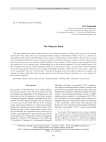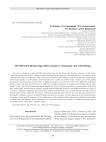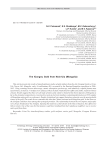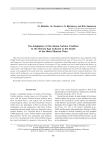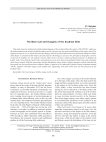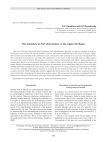The metal ages and medieval period. Рубрика в журнале - Archaeology, Ethnology & Anthropology of Eurasia
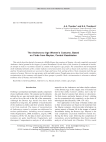
The Andronovo age women's costume, based on finds from Maytan, Central Kazakhstan
Статья обзорная
Бесплатно

The Aul-Koshkul-1 Cemetery in the Baraba Forest-Steppe: Findings of a Multidisciplinary Study
Статья научная
We present the results of aerial photographic and magnetometric studies at Aul-Koshkul-1, a group of mounds in the Baraba forest-steppe. Photogrammetry proved highly efficient for constructing orthophotographic plans and digital models of outward features at archaeological sites. Data were processed with an original approach, generating a map of relative heights, decreasing the effect of natural relief and highlighting altitudinal anomalies of an anthropogenic origin. Aerial photography is highly efficient for revealing archaeological features that are hard to locate by visual analysis of the surface (mounds destroyed by tillage, shallow ditches, etc.). Orthophotographic plans constructed by aerial photography in oblique sun rays at sunset present the most contrastive representations. Aerial magnetometry revealed most mounds at Aul-Koshkul-1, although the site was surveyed with minimal accuracy because magnetic anomalies caused by archaeological features were rare. Our multidisciplinary study yielded new information about the mounds previously registered by ground-based magnetometry, and discovered new features, leading to a revision of the cemetery’s reconstructed boundaries and composition. The study demonstrates the great potential of a joint use of aerial magnetometry and aerial photography for locating and studying archaeological sites at a new, sophisticated level.
Бесплатно
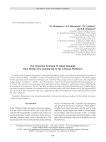
The Chemical Analysis of Glass Samples from Roman Era Cemeteries in the Crimean Piedmont
Статья научная
We assessed the chemical composition of more than 40 fragments of glass vessels from the Roman Period cemeteries in the Crimean piedmont— Druzhnoe, Neyzats, and Opushki, using X-ray spectral microanalysis. The results suggest that the glass from all the cemeteries belonged to the soda-lime-silica group, based on natural soda. The samples fall in glass groups “Levantine I”, “HIMT”, and “Roman glass”, typical of central and peripheral Roman manufacture in 0–500 AD. Most vessels are made of glass with a high content of iron, manganese, and titanium, as in the HIMT group, most common in Europe since 300 AD. The likely workshops are those in the Syro-Palestinian area, northern Egypt, and Sinai, pointing to contacts of the northern Pontic with other parts of the Greco-Roman world. The composition of glass from all the three cemeteries is the same, suggesting that the sub-mountainous Crimea imported glassware from the same workshops.
Бесплатно
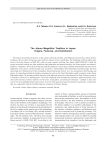
The Jomon megalithic tradition in Japan: origins, features, and distribution
Статья обзорная
Бесплатно
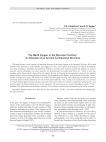
The Marfa kurgan in the Stavropol territory: an example of an ancient architectural structure
Статья обзорная
Бесплатно
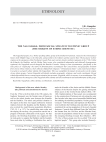
The Nagaybaks: from social stratum to ethnic group (the origins of ethnic identity)
Статья обзорная
Бесплатно

Статья научная
Archaeological fi ndings suggest that the Pazyryk burial chambers made from larch logs replicated dwellings, being a key symbol of culture. Log structures were built on both winter and summer pastures. Parts of them were placed in graves as substitutes for entire houses. Their inner structure corresponded to that of the house. All artifacts in the graves had been used in everyday life, being intrinsically related to the owners’ earthly existence. Felt artifacts functioned in the same way in elite burials and in those of the ordinary community members, although their quality was different. Felt carpets decorating the walls of the Pazyryk leaders’ houses were true works of art, while those found in ordinary burials were simple and rather crude. The typical form of the late 7th–3rd century BC wooden burial chambers in the Altai-Sayan was pyramidal. In the Southern Altai, this form survived until the 1800s–early 1900s in Telengit aboveground burial structures.
Бесплатно
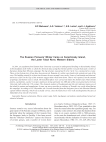
The Russian pioneers' winter camp on Karachinsky island, the Lower Tobol river, Western Siberia
Статья научная
In 2014, an expeditionfrom Tyumen State University excavated an underground dwelling on Karachinslqt Island, in the floodplain of the Tbbol, to check the chronicle data saying that Yermqk qnd his Cossacks had spent q winter at that place during their Siberian campaign. The log structure, measuring I0 m by 5 m by 2 m, consisted of two rooms. Three or four bottom tiers of logs have been preserved. Remains of a cellar were found in the central part east of the oven. The building existed for a short time because the area around it was sterile. Lenses of calcination and charcoal, and traces of fire on the logs of the structure suggest that it had burnt down. Then it was repaired, but the amount of garbage and kitchen waste is small. All household effects were carried out before the dwellers left. Finds include pottery, a grindstone, a potter s scraper, and pieces of slag and metal. An AMS date of the wood, generated at Arizona University, falls within the 17th century. The chemical analysis of background and old soils indicates intense use of the islandfor pqsture and manufacture. In sum, our survey provides no evidence of Yermak's stay on the island during his campaign. According to R.G. Skrynnikov, the Cossacks marchedfrom the Stroganov forts to the Siberian Khanate capital without wintering, which was tactically correct, since the Thtar forces were weak and fragmented because of Mametkul's foray into the Ural towns.
Бесплатно

The Tamga signs of the Turkic nomads in the Altai and Semirechye: comparisons and identifications
Статья обзорная
Бесплатно
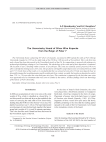
The Umrevinsky hoard of silver wire kopecks from the reign of Peter I
Статья научная
The Umrevinsky hoard, comprising 107 silver wire kopecks, was found in 2008 outside the walls of Fort (Ostrog) Umrevinsky, founded in 1703 on the right bank of the Ob River, 100 km north of Novosibirsk. This is the fi rst time such a hoard has been discovered in the Novosibirsk stretch of the Ob. Its composition is assessed with reference to archaeological fi ndings relating to Fort Umrevinsky. The chronology of the coins and of their deposition is evaluated. The location is near a dwelling within a manor, in an ash-layer. The coins are relatively poorly preserved. We were able to identify the minting-years of 34 coins. All specimens with legible stamp-impressions were minted between 1696 and 1717. On the basis of the results, it is concluded that this was a hoard of coin-silver. Firstly, most kopecks bear no discernible images that would guarantee specifi c weight and silver content; secondly, the hoard was deposited no earlier than 1735, i.e., 20 years after the coins had gone out of use. This conclusion is supported by the fact that some coins were apparently used as ornaments that were sewn on clothes by the natives. All these fi ndings enrich our knowledge of the history of Fort Umrevinsky.
Бесплатно
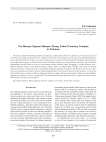
The Wanyan Digunai (Wanyan Zhong, Esikui) funerary complex in Primorye
Статья научная
The article outlines the findings of studies of a funerary complex beside the stone sculpture of a bixi turtle, discovered in 1893 on the territory of the mill of O.V. Lindholm in Primorye. The present research is based on unpublished diaries (from 1893 and 1894) of F.F. Busse, who carried out rescue excavations of the hill under the sculpture and unearthed a stone coffin buried nearby. A rounded stele top with 20 Chinese characters was found at the same place. The translation demonstrates that the burial was that of a prominent Jurchen military leader belonging to a noble Wanyan clan— Wanyan Digunai (Chinese name Wanyan Zhong, 完颜忠 , known as Esikui/Asukui, 阿思魁 ). The burial was largely neglected, because scholars focused on translating and interpreting the inscription. The burial was believed to have been looted long ago, and Busse's diaries remained unpublished. The focus of the present study, therefore, is to describe all available sources relating to Wanyan Digunai's funerary complex. Based on the analysis of the excavation findings, features of the funerary rite are reconstructed. The architectural design and layout of the complex are shown to have followed the local East Asian tradition.
Бесплатно
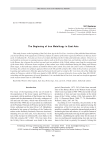
The beginning of iron metallurgy in East Asia
Статья научная
This study focuses on the beginning of the Early Iron Age in the Far East. A revision of the published data indicates a lack of synchrony in the appearance of bronze artifacts in cultures of the Amur region and Primorye in the late 2nd to early 1st millennia BC. Iron and cast iron were widely distributed in the Urilsky and Yankovsky cultures. However, no such artifacts are known in contemporaneous cultures such as the Evoron, Siniy Gai, and Lidovka, which are attributed to the Bronze Age, whereas the earliest iron and cast iron artifacts of the Urilsky culture come from the western parts of the Amur basin. All known bronze artifacts of that culture were widely distributed during the Shang and Western Zhou stages, in Karasuk-type cultures of Southern Siberia and Central Asia of the late 2nd to early 1st millennia BC. In China, the earliest iron artifacts appeared between the 8th and 6th centuries BC, while in the provinces of eastern Liaoning and southwestern Jilin they appeared between the 4th and 1st centuries BC. Cast iron celts of the Yankovsky culture in Primorye, which in 1960s were dated to 1000–800 BC, are now believed to be no earlier than 400–200 BC, coinciding with the appearance of iron in Manchuria. It is concluded that in East Asia, iron and cast iron first appeared in the western Amur basin in 1100–900 BC.
Бесплатно

Статья научная
This article presents a current perspective on the historical and cultural development of the population in the foreststeppe zone of the Ob-Irtysh interfl uve in the Stone and Bronze Ages, using various methods of the natural and exact sciences, as well as archaeological fi ndings from adjacent parts of the Ob and Irtysh basins. A geographic description of the region is given. The history of excavations in the region is outlined beginning from the 19th century to the present. A considerable amount of new materials has been accumulated, providing the basis for historical and cultural reconstructions. The study spans the period from the Upper Paleolithic through to the Late Middle Ages and the recent centuries. The initial peopling of the Baraba forest-steppe occurred 18 thousand years ago. Cultures of the Early and Late Neolithic, Early, Middle and Late Bronze Ages, and the transition to the Early Iron Age are listed. All periods have a reliable timescale. The archaeological potential of the region provides a basis for further elaborations of this model.
Бесплатно


